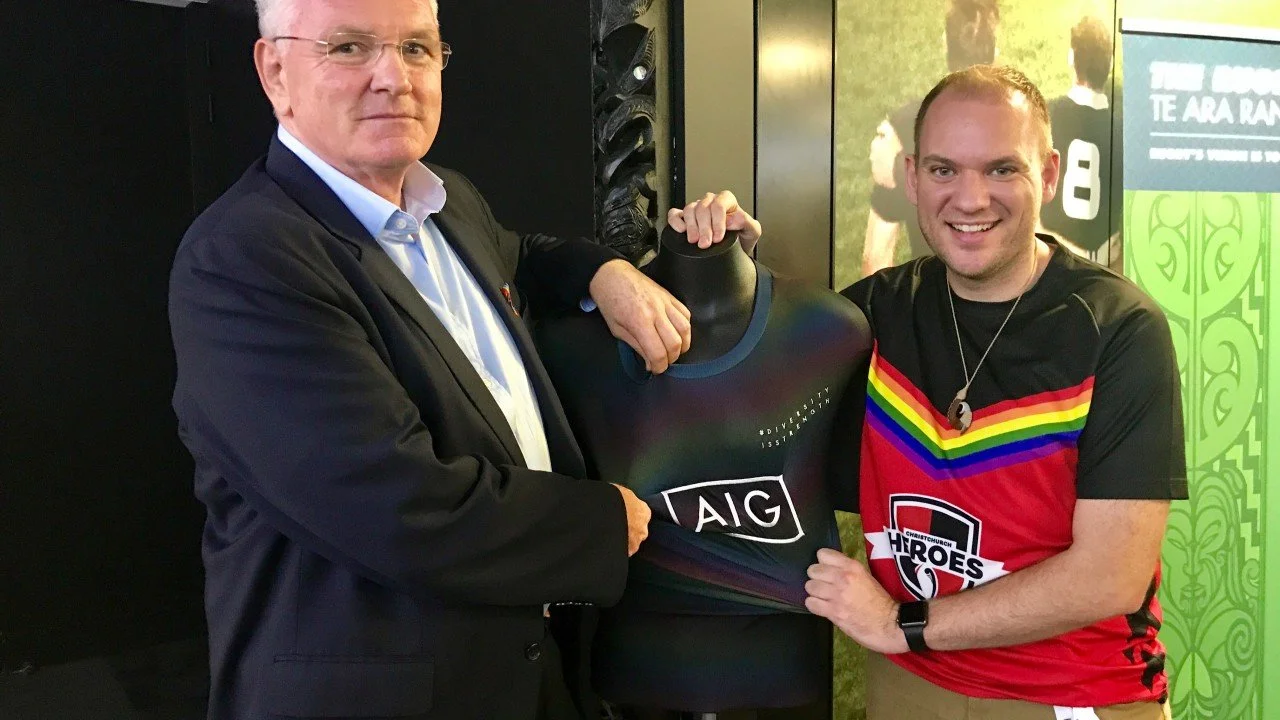Why Rainbow Advocacy: Building Global Movements from Intersectional Roots
David Rutherford, former Chief Human Rights Commissioner, and I are stretching the All Blacks rainbow rugby jersey.
Why Rainbow Advocacy?
My why is simple: because visibility, dignity, and equity are not privileges — they are rights.
Rainbow advocacy is deeply personal to me. I identify as bisexual and androphilic (attracted to men and masculine people), and my sexuality sits under the Bi+ umbrella, a term that includes bisexual, pansexual, fluid, and queer identities. Yet bisexual people remain the “minority within the minority,” too often erased, sidelined, or rendered invisible even inside Rainbow spaces.
That is why I’ve dedicated much of my life to Rainbow advocacy, both here in Aotearoa and globally. From being the first Chair of the ILGA World Bisexual Steering Committee, to serving on the ILGA World Board for 10 years, to my ongoing mahi as Treasurer, Board Member and Co-Chair at ILGA Oceania, my why has always been about making space: for all rainbow people, for trans and gender diverse or non-conforming people, for bisexual people, for Indigenous peoples, for disabled voices, for those who are too often left out of the room.
“My why is to use my intersections not as barriers, but as bridges, to help carve out space for others to thrive.”
Organising Across Borders and Identities
Rainbow advocacy is powerful. But it is also hard.
Hard because of time zones: I’ve sat on countless calls that stretch deep into the night, negotiating with activists across Africa, Asia, Europe, and the Pacific.
Hard because of resources: So many of our NGOs run on aroha, passion, and the unpaid work of volunteers. Many have no money but are still expected to deliver high-level advocacy and services.
Hard because of erasure: As a bisexual advocate, I’ve seen Bi+ identities minimised or left out of policies, reports, or conference agendas. Even in Rainbow spaces, the “B” is sometimes silent.
When I became the first Bisexual Steering Committee Chairperson at ILGA World, I knew my role was about more than advocacy. It was about building infrastructure: developing data, representation, and visibility for Bi+ people globally. It meant challenging narratives that said bisexuality was temporary, transitional, or confusing. It meant insisting that bisexual people — who make up the largest proportion of the LGBTQIA+ community — must never again be erased from our own movements.
“Bi+ identities are not a footnote in our movement. We are the majority of the Rainbow, and yet still the most erased.”
Intersectionality in Rainbow Spaces
Intersectionality, as Kimberlé Crenshaw reminds us, is about recognising that no one lives a single identity at a time. That’s why my Rainbow advocacy has always been intersectional.
I bring to the table not only my bisexuality, but also my whakapapa as Māori and Pacific, my lived reality as a disabled person, and my takatāpui identity. These intersections have taught me that true inclusion means opening space for others who carry multiple, overlapping realities.
At ILGA Oceania and ILGA World, I’ve worked to embed intersectionality into every campaign:
Marriage Equality Campaign in Aotearoa (2013): as Community Campaign Manager, ensuring that bisexual, takatāpui, disabled, and Māori voices were visible and central in the push for equality.
Decriminalisation of homosexuality in the Pacific: supporting movements in six countries to challenge colonial-era laws, often at personal risk.
Capacity and capability building: helping volunteer-led NGOs build transparent governance, administrative best practices, and financial systems, so they can professionalise and thrive.
UN human rights mechanisms: contributing to Universal Periodic Review (UPR) submissions, supporting the voices of Rainbow communities to appear in reports to the UN Human Rights Council (UNHRC), and ensuring references to Indigenous and disabled Rainbow people appeared in Special Rapporteur reports.
UNCRPD (Convention on the Rights of Persons with Disabilities): highlighting how disabled Rainbow people are often ignored by both disability and Rainbow systems.
UNDRIP (Declaration on the Rights of Indigenous Peoples): connecting takatāpui and Māori voices with Indigenous struggles globally.
CHOGM (Commonwealth Heads of Government Meeting): ensuring Rainbow issues — especially decriminalisation — were on the agenda for Commonwealth leaders.
Everywhere I’ve worked, my intersectional approach has been about opening doors. Whether that’s for Pacific Rainbow leaders who need resourcing, for Bi+ activists silenced in their own countries, or for disabled advocates whose accessibility needs are not met at international meetings.
“Intersectionality in Rainbow advocacy means ensuring the most marginalised among us are not just present, but leading.”
My Why in Rainbow Advocacy
So why Rainbow advocacy?
Because I know what it feels like to be erased. And because I believe every campaign, every policy, every report must ask: who is missing here?
It’s why I have stayed up all night to contribute to a Universal Periodic Review report. It’s why I have helped NGOs with no budget create financial transparency systems. It’s why I have travelled across the Pacific, listening to communities criminalised for who they are, and bringing their stories to international platforms.
Rainbow advocacy is not easy. But it is hopeful. Because every time a law changes, every time a bisexual or takatāpui youth sees themselves reflected, every time a disabled Rainbow leader is resourced to speak at the UN — we create ripples that change the world.
“My why is to leave behind a Rainbow movement that is bigger, braver, and more inclusive than the one I entered.”
🔗 Follow me for more reflections on systems change, equity leadership, and human rights diplomacy.
🖤 Ko te pae tawhiti whāia kia tata. Ko te pae tata whakamaua kia tīna. | Seek out the distant horizons so they may become close. Hold fast to the close horizons so they may be secured.


